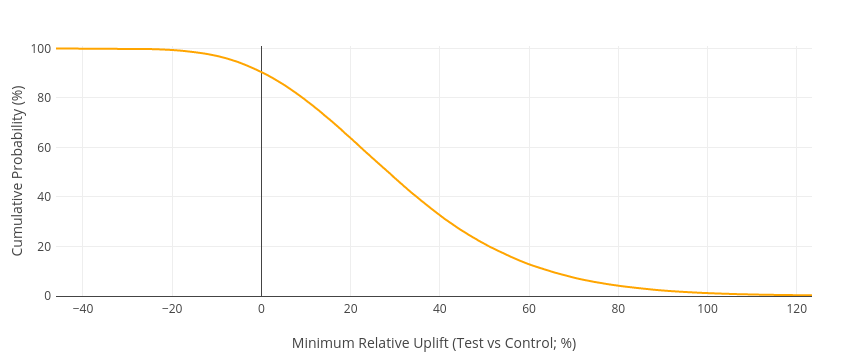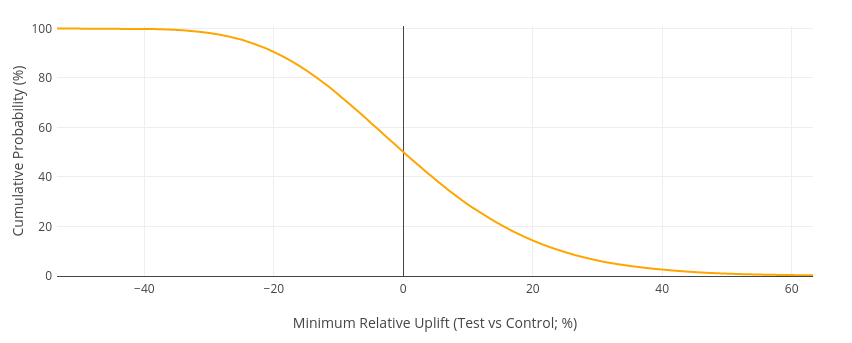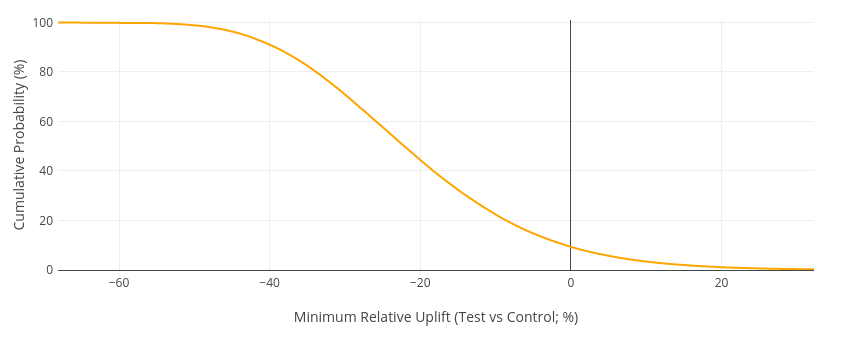Calculator
Input Parameters
The terms trials and successes should be considered as placeholder terms for the interactions you wish to measure. Depending on your specific requirements, a trial could be a reference to a unique user count, or a unique page-view event.
- Trials: All interactions (successful+unsuccesful)
- Successes: All successful interactions
- Control: Denotes the unchanged, original version of your site
- Test: Denotes the modified version of your site. Also referred to as the treatment group
Example
You are running an e-commerce site that has a product list and a product detail page. You would like to test if a re-design of your product list leads to more users advancing to the product detail page.
- Views: All unique users that visited the product list, irrespective of whether a user has visited the product detail page
- Hits: All unique users that visited the product list AND who subsequently visited the product detail page (and only those)
Input Parameters - Expert Settings
Info
For a fuller explanation of these terms check out the Glossary
ROPE
Region of Practical Equivalence, in percent (%), expressed as an absolute value integer
Example: If you consider all changes between -2% and -2% as being identical. set ROPE = 1
Prior
- Prior Alpha: Prior value for successes
- Prior Beta: Prior value for trials
Example: Historically, the click-through-rate of your product list has been around 20%. Given the success-rate, you could choose a weaker (alpha = 1; beta = 5) or a stronger prior (alpha = 1000, beta = 5000)
Plot
Interpretation
The Expected Uplift Plot provide a convenient and intuitive way to evaluate experiments. While the x-Axis denotes the Minimum Relative Uplift that version Test provides over the Control version, the y-Axis assigns a probability (chance) to each point along the x-Axis. Taken together, each point along the chart can thus be read as:
Given the data so far, there is a y% probability of version Test being at least x% better than version Control
When analyzing a split, special attention should be paid to the vertical line originating at x = 0. Since all values to the right of this "zero-uplift" threshold can be considered an improvement, the probability given by the y-value at the intersection between this line the probability-curve, offers a quick way of evaluating how well the Test version is performing.
Examples
Test with higher success rate
The cumulative probability curve crosses the zero-uplift threshold at around 90%.
Thus, there is a 90% chance, that version test is at least as good as the control version!
At 80% probability, the new version provides an uplift of at least 15%.

Test and Control with equal success rates
The cumulative probability curve crosses the zero-uplift threshold at exaclty 50%.
Thus, the probability of one version being better than the other is just the same as getting heads when flipping a coin.

Test with lower success rate
The cumulative probability curve crosses the zero-uplift threshold at around 10%.
Thus, there is only a 10% chance, that version test is at least as good as the control version!

Recommendation
Troubleshooting
Running the same numbers multiple times yields different results - what's wrong?
Nothing. The probability estimates are derived using random sampling methods. Running the calculation again thus leads to different samples being drawn. Note however, that running calculations multiple times using the exact same inputs should only cause results to differ marginally.
How do I know when to stop my experiment?
The calculator comes with a The stopping-criterion is determined by two factors: The HDI and the ROPE. The way these two measures directly translates into three different recommendations:
- The HDI is completely contained within the ROPE -> End the experiment, implement either variant
- HDI and ROPE are partially overlapping -> Keep testing
- HDI and ROPE are not overlapping -> End the experiment, implement winning variant